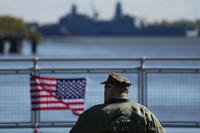Fully half of the COVID-19 cases diagnosed in active-duty military personnel through the end of fiscal 2020 were among those working in the repair, engineering, communications and intelligence fields, a new report shows.
Results were nearly identical among the Reserve component and National Guard, with the same occupations combining to make up 46% of cases, according to the Defense Department's December edition of the Medical Surveillance Monthly Report
According to the report, of the 29,970 COVID-19 cases recorded among active-duty personnel through Sept. 30, 2020, 28% were among those in the repair or engineering fields, while 22% occurred in the intelligence or communications specialties.
Read Next: More Democrats Say They Will Vote 'No' on Austin Pick for SecDef
About 20% of cases had no determination of military occupational specialties, while nearly 14% were "combat-specific." More than 9% of all cases were health care personnel.
For the Reserves and National Guard, which had 2,498 cases in that timeframe, the repair and engineering military occupational specialties accounted for 23.3% of cases, while communications and intel made up 22.9%. The occupations of roughly 30% were unknown, while 8.1% of cases were in health care and 7.3% were in combat-specific specialties.
A researcher with the Army Public Health Center said they could not explain why those job fields made up the bulk of the cases, and declined to speculate.
Jobs such as repair, maintenance and engineering require on-site work without much opportunity for telework, while military intelligence and some communications jobs must be done in offices, often in secure environments.
Ralph Stidham, an epidemiologist with the U.S. Army Public Health Command Central Region, added, however, that the data shows that everyone in the military health system needs to "do our part to decrease the spread of transmission of COVID."
"We need to do our part -- obviously, the CDC recommendations for physical distancing, wearing face coverings, quarantining when necessary and exercising proper hand hygiene so we can keep hospital beds open" for those beneficiaries with severe cases or other conditions, Stidham said.
The researchers analyzed the medical records of 53,048 patients in the military health system with confirmed or probable cases of COVID-19. Of those, more than half, or 56%, were on active duty, 19% were dependent family members, 12.8% were recruits, 5.8% were retirees and 4.7% were Reserve or Guard members.
Among the active-duty troops, the most commonly diagnosed were young, non-Hispanic White males, which "follows the expected distribution" of the services, according to the report. The bulk of the active-duty cases were in the Army -- the largest service, making up more than one-third of all active-duty personnel. Next was the Navy, followed by the Air Force, Marine Corps and Coast Guard.
Cases among military dependents occurred most commonly in female spouses. Among retirees, older males had the bulk of cases.
In terms of geographic region, cases were highest among each population in the South, which had 62% of all active-duty, 64% of all recruit, 64% of all National Guard, 68% of all dependent and 73% of all retiree cases.
Early in the pandemic, some Southern states were slow to embrace mask mandates and eschewed lockdowns, facilitating the spread of the SARS-CoV-2 coronavirus. States like Florida and Georgia -- homes to numerous military installations and retiree populations -- still don't require mask-wearing in public spaces, although some local jurisdictions have instituted them.
According to the report, more than one-third of the military beneficiary COVID-19 cases were diagnosed with one or more health conditions that put them at higher risk for more severe symptoms. The top concurrent condition in service members was being overweight, followed by cardiovascular disease; for dependents and retirees, they were cardiovascular disease and metabolic disorders.
Of the 1,803 patients hospitalized for COVID-19 in the military health system, 34% were retirees, according to the report. But given that more than 3,000 retirees contracted COVID and less than 650 were hospitalized, Stidham said the researchers thought the number was surprisingly low.
Stidham said the "healthy soldier effect," which denotes the idea that military populations are likely to be healthier and more fit than the general population, may have played a role in the relatively low number of hospitalizations and deaths for all populations during the study period.
"We were expecting the largest number of hospitalized patients to be among our retirees, but in our analysis, it was about 20.2% [of retiree cases]," he said. "Maybe the healthy soldier effect for the seniors -- maybe they've always been in relatively good shape."
After Sept. 30, COVID cases in the U.S. military have risen significantly, as have deaths. As of Jan. 11, more than 189,000 persons affiliated with the Defense Department have been diagnosed with COVID-19, including 120,106 military personnel and 19,772 family members.
More than 206 have died, including 15 service members, nine dependents, 137 civilian employees and 45 defense contractors.
-- Patricia Kime can be reached at Patricia.Kime@Monster.com. Follow her on Twitter @patriciakime.
Related: Illinois VA Head Quits in Wake of Outbreak at Homes













